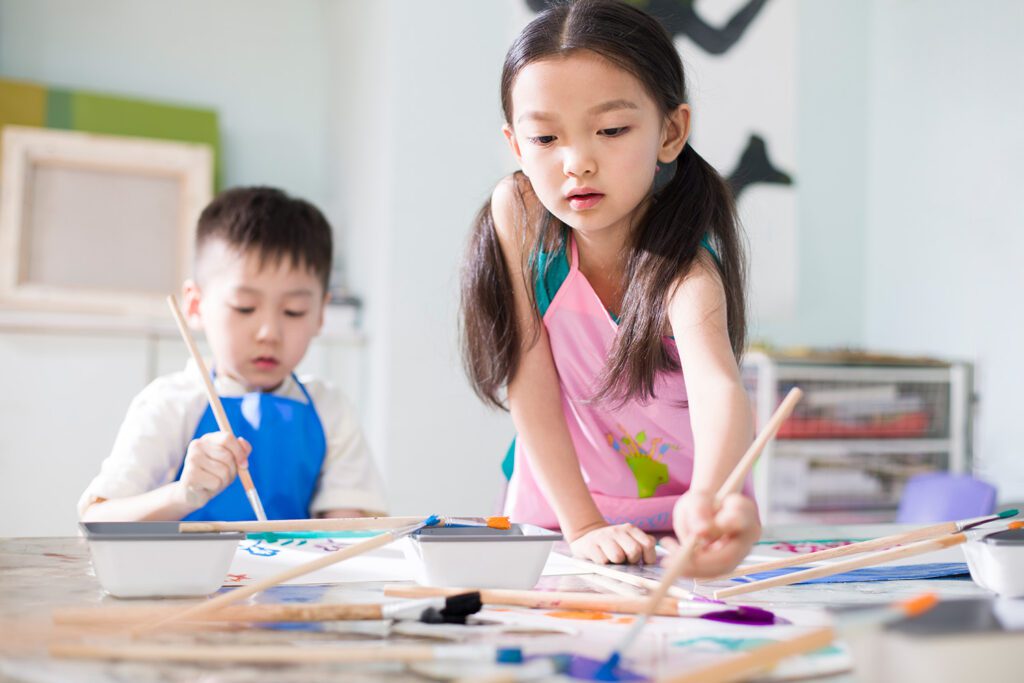Introduction
Art therapy is the use of art-making and the creative process to support the more traditional therapeutic process.
Sessions are facilitated by a board certified, registered art therapist to address desired goals. Art therapy sessions will often involve the use of an art directive(s) to work towards the desired treatment goals.
Art-making involves the use of visual arts, for example painting, coloring and drawing to help build self-esteem, promote increased socialization, develop coping skills and many more.
In this article we are going to talk about some of the incredible benefits of art therapy for children.

1. Boosts Mental Health
Engagement in art-making and the creative process itself can help to promote a sense of relaxation and ease and certain art materials and directives, such as paint, mandalas, clay, can further help to create that feeling.
Additionally, art-making can be used to better understand symptoms and presenting issues. Working with art in these different ways can help to both address and reduce experienced symptoms of anxiety and depression.
Art therapy can be used to help with PTSD and trauma in a similar way. Certain art directives may also support children to find a sense of safety, which is often affected by experienced trauma.
Engaging in art therapy can also help to find increased connection to the body, where trauma is often stored.
Art therapy ultimately allows for children to access their right brain-the creative side, the subconscious, which can further allow for increased healing that traditional talk therapy or language can not always do.
2. Helps Manage Stress
As mentioned above, engaging in art-making itself can help to reduce experienced stress, allowing for children to get into their bodies and out of their thinking minds.
Using certain art directives can serve as a way to release and express healthy feelings of frustration. For example, an art directive may involve scribbling to release frustration and stress, followed by ripping of the page and last glued back together to create a new piece of art.
Some art directives may promote mindfulness in the needed attention, for example to create a mandala. The observation of and attention to the various steps in certain art directives can also promote a sense of increased mindfulness.
3. Fosters Self-Discovery
In engaging in art therapy and the creative process, children may find themselves working through various obstacles, challenges and may learn about themselves as a result as well.

Creativity and art-making may also help children engage and tap into their inner child through play, this may also help them discover and explore possibly repressed feelings or sides of themselves.
When working with certain art mediums, children may encounter feelings of frustration, similar to situations they may experience in their daily lives. Being supported by the therapist in their process may help them find ways to adapt to these challenges.
4. Develops Coping Skills
The creative process may trigger certain feelings, either due to the materials used in the session or what may be discussed in the session. Using art-making and engaging in the process itself can be a form of relaxation and coping.
Learning and using art materials appropriately can also help in emotion regulation.
5. Improves Cognitive Function
Art-making can have positive benefits on brain health as it exercises the right side of the brain.
Art therapy directives may ask that children practice sustaining their attention which can increase memory and focus.
Art-making can also help clients with Alzheimer’s and dementia tap into their subconscious and moments where they have made art in the past.

6. Enhances Communication
Engaging in art therapy and the creative process allows for new and alternative ways to communicate when words don’t feel “enough.”Communication through art can be using colors or images which may reflect situations, emotions or even subconscious thoughts and beliefs.
This can be especially helpful for children on the spectrum who may struggle to communicate verbally.
The motivation that the art-making may provide can also serve as a way to increase a client’s ability to request or ask for certain materials.

7. Builds Relationships
One of the most important parts of art therapy is the therapeutic relationship-the client-therapist relationship. A sense of safety, comfort and feeling seen can help client form relationships in new ways.
Finding this relationship with the therapist can help model relationships for outside relationships. Art-making can also be used as a way to help connect family members and couples
8. Boosts Confidence
When there is an interest or mastery in art-making, one may feel an increased sense of confidence when able to use art-making as a way of expressing themselves. Additionally, the ability to see a finished product can also help increase an individual’s sense of accomplishment.

Directives that are more geared towards self confidence can also allow for individuals to explore and build on their sense of self. For example, creating a self portrait for how we see ourselves can help an individual gain a different perspective on how they look or feel.
Additionally, being able to learn and possibly mastery the use of a certain art material may also help individuals to feel more confident with their work.
9. Cultivates Empathy
At times, art therapy directives may offer and help children to gain a sense of perspective on a certain situation or individual which, in turn, may increase a person’s empathy and ability to understand others. In creating our own art and dealing with our own feelings that present themselves, we may also be able to better understand those of others.
For those in helping professions, art therapy may offer a safe space to engage in increased self care and relaxation.
10. Promotes Physical Healing
Those who suffer from chronic pain and illness will often also experience low self-esteem, difficulty coping with or identifying their feelings-all of which engaging in art therapy can address.
Additionally, the use of meditative and relaxing directives may also help individuals distract themselves from their experienced pain and discomfort. This can be very useful for those that are undergoing medical treatment or in a hospital.
Certain art materials may also help individuals strengthen areas of their bodies that may be affected by their illness. For example, using clay to strengthen and regain fine motor control.
Some Quick FAQs About Art Therapy
What is the difference between art therapy and traditional art-making?
Art therapy is facilitated by a board certified and registered art therapy who may use art-making as a therapeutic tool or may use art-making to support the psychotherapy process. Traditional art-making can be done alone. Art therapy is often process oriented whereas art-making may be more concerned with the product created.
Is art therapy only for artists or creative individuals?
No, art therapy can be for anyone who has an interest in art-making, regardless of experience.
How can I find a qualified art therapist?
The American Art Therapy Association has an “Art therapist locator” where you can find credentialed art therapists.
Can art therapy be used in conjunction with other forms of therapy?
It can. However, it can also be used as a primary form of therapy.
Is art therapy covered by insurance?
This depends on state by state licensure and on the insurance. More information on the insurances we accept and what is covered, please see our ‘Accepted Insurance Plans‘ page.
What materials are typically used in art therapy?
Markers, crayons, colored pencils, different types of paint, collage, clay, model magic, play dough. Some art therapists may also use less traditional art materials-there is no limit to what art materials can be used.
Can art therapy be done remotely?
It can! So long as there is access to art materials.




0 Comments